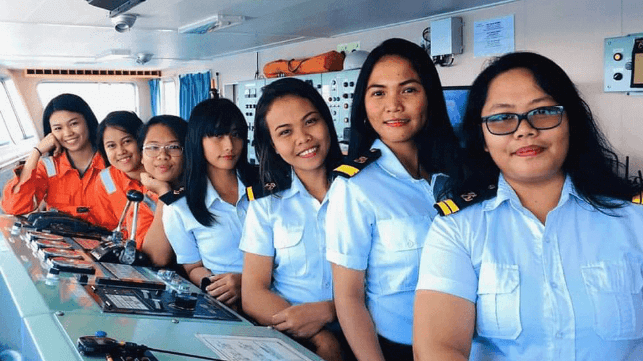You are here
"Pain Points" for Female Seafarers ID’ed to Make Profession Inclusive
"Pain Points" for Female Seafarers ID’ed to Make Profession Inclusive
Apr 27, 2023 https://maritime-executive.com/article/pain-points-for-female-seafarers-...
(Image courtesy WISTA / IMO)
A new study released by the Global Maritime Forum and the All Aboard Alliance looks at the challenges faced by female seafarers as it looks toward improving living and working conditions for women at sea. The report is the first effort which will be followed by a second phase later this year that seeks to test proposed solutions to impact the key pain points identified for female seafarers.
The All Aboard Alliance, which was formed in 2021 and currently involves 36 companies, seeks to make the career at sea not just more inclusive but also attractive to more women as seafarers going forward. The efforts were launched in May 2022 when they brought together senior leaders from across the maritime industry as part of the effort to make the maritime world more diverse, equitable, and inclusive.
The qualitative study was based on 115 anonymous interviews with women seafarers from all ranks and geographies. They interviewed women ranging from captains to deckhands, with the majority (59 percent) with a rank of one stripe, with fewer women (17) being more senior officers, and a similar number (22) being able-bodied (no stripes) seafarers. They spoke with women on all types of ships and a total of 23 different nationalities. Approximately two-thirds of the women (63 percent) were from Asia (mainly the Philippines and India) while a quarter were from Europe.
The report breaks down the issues reported into four broad categories ranging from difficulties to succeed in the profession to employment challenges at sea, challenges of social relationships and interactions at sea, and the physical conditions onboard. They identified a total of 15 key pain points within the industry for female seafarers.
Male chauvinism continues to be prevalent in the industry where the organizers report only two percent of the total seafarer population is female. Respondents highlighted a feeling of being treated as “less competent,” being assigned different tasks based on gender and being denied access to training. Many of the women said they felt they needed to outperform male colleagues just to be perceived as competent. Some of the women reported that they are still finding companies that simply do not want to recruit women.
Onboard ships in addition to the ever-present fears of sexual abuse and harassment, women like their male counterparts reported power abuse by officers and people in supervisory positions. Women however also said they felt like they were being constantly judged and that it is an environment that breeds rumors and gossip. Women like men reported feelings is isolation and loneliness, although possibly made worse by the imbalance between the number of men versus women in the crew.
Finally, many ships remain poorly designed and outfitted for women. They spoke of a lack of changing rooms, bathrooms, laundry areas, and alike. Equipment they said is often designed for men with less access to appropriate and properly fitting PPE, boilersuits, fire suits, boot sizes, and alike.
“We need to make life at sea more inclusive to women seafarers,” said Su Yin Anand, Head of Shipping at South32 and Co-Chair of the All Aboard Alliance while announcing the report’s findings. “But now that we have a better understanding of what the pain points are, we can work together to address them. We do not want them to leave their careers at sea because we need them – and we need many more.”
While the report covers a broad spectrum of issues and focuses on how they are impacting female seafarers, the sponsors note that many of the points also impact male seafarers. While less talked about, they said men also experience issues such as bullying and harassment, feelings of isolation, and the pain of long contracts which keep them away from families.
“These issues must be addressed,” said Mikael Skov, Co-Chair of the All Aboard Alliance, and CEO of tanker operator Hafnia. “The maritime industry is changing rapidly, and more advanced skills are needed – ones which require us to holistically look at the full talent pipeline to identify the best candidates – for the maritime sector to thrive and grow.” He notes that Hafnia in 2022 launched its Maritime Culture Lab aboard four vessels with at least 50 percent women to learn about the nuances and impact of a more diverse crew.
The All Aboard Alliance report is the first coming out of the Diversity@Sea workstream, which also aims to explore how the maritime industry can collectively make a career at sea more diverse, inclusive, and attractive to a broader pool of talent. They note that the shipping industry has some of the lowest numbers of women in the workforce and that this is at a time when the industry is facing acute shortages of qualified seafarers.
In the next phase of the project, a select group of vessels with higher-than-average numbers of women officers and crew onboard will be used to test potential solutions based on the finding from the interviews. They will look at how these recommendations impact the pain points and hope to develop a model that can be used broadly across the industry to make the seafarer profession more attractive to women.
The full report (https://smooth-storage.aptoma.no/users/drf-dn/files/TradeWinds/All_Aboar...), with excerpts from the interviews, is available online.

